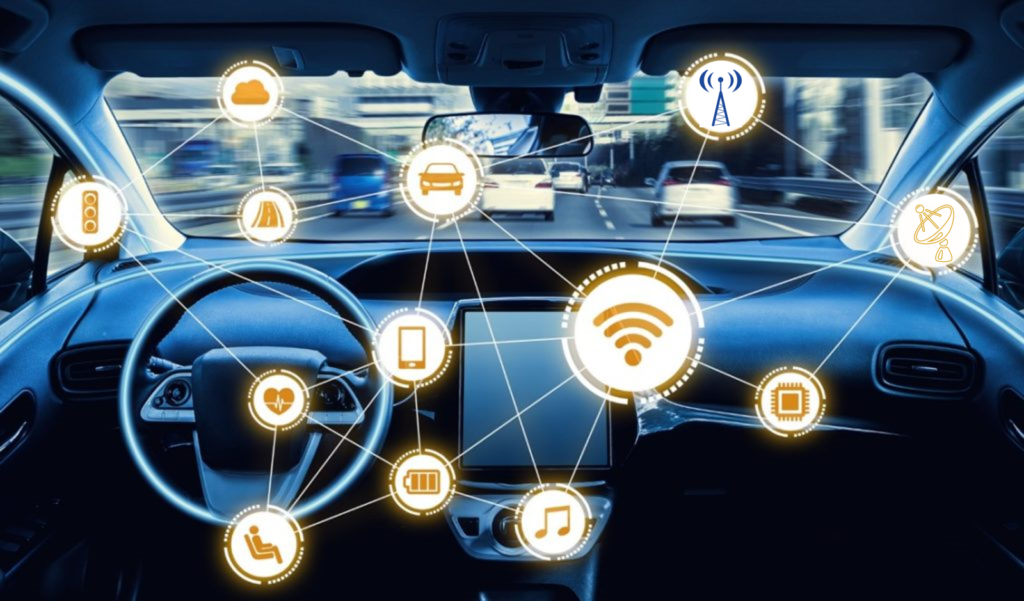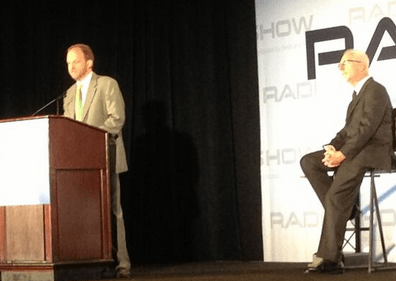
I first met Roger Lanctot about a decade ago, even before our first DASH Conference. Paul and I were already visiting CES, videotaping interviews with auto experts, and packaging them in presentations for the radio industry.
Roger is Director, Automotive Mobility and Global Automotive Practice for Strategy Analytics. Roger spends most of his waking hours crossing time zones, meeting with and advising automakers and industry heavyweights across the globe. Roger is also a prolific writer, penning great reports for Strategy Analytics clients. And as a result, he is a student of the game, a voracious learner and serial reader who makes it his business to know everything there is to know about where the automotive ecosystem is headed.

Photo: Media Confidential
Thanks to Arbitron and the NAB/RAB, Roger and I first tag-teamed a keynote at the Radio Show in 2013. He represented the view from the auto world and I spoke for radio broadcasters. We hit it off instantly, both passionate about radio and cars, and where those two storied industries intersect.
We went on to collaborate with Roger on other projects, frequently meeting up at gatherings like CES, TU Automotive, our DASH Conferences, and other radio get-togethers, conventions, and company meetings.
The fun part about having a friend in an allied industry is that we get to use each other to “test drive” our ideas against the other’s key area of specialization – and it works. Roger always wants to understand the radio broadcasting mindset, and I’m equally curious about the goings-on inside the conference rooms of auto companies.
Last month, Roger had questions about metadata in dashboard display screens – and off we went. He wondered why more radio stations haven’t taken a more proactive approach to “programming” text and artwork displays in order to enhance the on-air product. I told Roger about a major audit Jacobs Media conducted in collaboration with the NAB back in 2017. And he wondered why more radio owners didn’t take it to heart. Or to their dashboard displays.
The end result for Roger – a white paper for Strategy Analytics clients only. But then Roger went public with a blog post in Radio World, ominously titled “Broadcasters Conspiring In Their Own Demise.” It is subtitled “To survive, radio must fix its management of metadata in dashboards.” He obviously wasn’t pulling any punches.
I invite you to read it. In fact, I urge you to read it. Like everything Roger does, it is well considered, it asks great questions, and it supports both the automotive and radio communities with no-nonsense ideas about how the two industries must work together – a cautionary tale that is under the radar.
To follow up on Roger’s blog post, he was kind enough to answer some probing questions that spell out the task at hand, and how radio broadcasters can best improve the in-car experience.
Fred Jacobs: Dashboard displays are only getting more elaborate and larger. Why has the way a radio station looks become such an important part of the consumer experience?
Roger Lanctot: Radio has been cut loose from the “radio dial.” We now have speech-based interfaces, gesture recognition, drop-down menus, steering wheel  controls, you name it. Choice is great. But choice introduces confusion. Choice is also opportunity. The scariest thing – for me – is simply the ability to FIND the radio in, for example, a rental car.
controls, you name it. Choice is great. But choice introduces confusion. Choice is also opportunity. The scariest thing – for me – is simply the ability to FIND the radio in, for example, a rental car.
Every auto maker has a different “take” on what to do with radio and what radio “is” and “means.” For some auto makers – which really means individual engineers who may have responsibility for designing the in-dash system for a few years before they move on to something else – the radio increasingly means audio apps.
Actually taking the time to ensure proper radio reception and a state of the art interface is increasingly difficult to prioritize. This concerns me. Radio in the dash used to be easy peazy. Now it’s a problem. Broadcasters have to do everything in their power to rescue it from being perceived as a problem.
FJ: Metadata may be one of those areas that falls between the cracks inside most radio stations. Is it engineering, programming, or even marketing? Any thoughts on who to best address the necessary strategic planning and day-to-day effort involved in who should be responsible for dashboard messaging?
RL: You’re right. This does cross the line from engineering to marketing. What most broadcasters may be missing is the importance of metadata to support station marketing and, dare I say it, advertising. Radio is increasingly a visual media. It is actually exciting, to me, when I see visual content in my dashboard radio. Frankly, there is not enough of it.
I know I am listening to (NPR’s) Fresh Air – but who is the guest today? What about the weather and traffic – that’s all available via the HD feed. An advertiser or sponsor? Bring it on. We all know Pandora isn’t shy about leveraging its digital pipe for visual advertising messages.
Failing to tend to metadata is a tragic oversight. I should think marketing and sales departments should have the organizational leverage to push these agendas forward – assuming they understand what is at stake.
FJ: Who are the companies best addressing the challenge and opportunity that exists for metadata for radio broadcasters?
RL: Companies like Radioplayer, Quu, Pluxbox, and some others are providing the infrastructure and service necessary to correct these broadcaster failings. Xperi is providing a global aggregated metadata platform to “fill in the blanks” and smooth out the rough spots where stations have not fulfilled their metadata obligations.
Companies like Quu, Pluxbox, and Radioplayer are taking on the challenge one broadcaster at a time. Of course, they are setting the stage for the likes of Instreamatic which is offering the latest iteration of interactive advertising which is only just beginning to emerge in the auto sector.
FJ: Why is it so important for broadcast radio to step up its metadata game? Do drivers (and passengers) pay much attention to the screen(s)?
RL: I think drivers and passengers are only just beginning to notice that there is more information available from broadcast sources than there has ever been before. It’s early days, but I think we have only just begun the process of educating consumers to the opportunities of a searchable, program guide managed form of broadcast delivery.
By getting metadata right, broadcasters will allow car makers to deliver on the promise of digital broadcast radio – i.e., HD Radio – where listeners can consume broadcast content in a “non-linear” manner. It is nothing less than a revolution, but it is happening quietly.
FJ: When you think about the best use of metadata on dashboards, should messaging go beyond artist/title of songs and the name of a show? Do you know of any research on what type of info drivers want?
RL: People don’t know precisely what they want. We all want more information and control but there are limits in a moving vehicle, if you are driving. Xperi is exploring additional value add opportunities such as event info, maybe the ability to buy merchandise or tickets, who knows? But getting the metadata right enables these opportunities and creates possibilities.
FJ: In your opinion, what is the greatest existential threat to radio’s dominance in the car – autonomous or display? Or something else?
RL: The existential threat is an app-driven ethos a la Apple Carplay or Android Auto that forces broadcasters into app-centric thinking. This is a rip tide that’s hard to resist or compete with. Looking at the hybrid experiences from Audi and Mercedes it is clear that the door is open to new thinking about the in-vehicle user experience. Once broadcasters understand how important this listening scenario has become, it should alter their thinking about broadcasting, marketing, sales, advertising, and listener engagement.
FJ: And your best advice to radio broadcasters, whether it’s the mega-companies or mom & pops?
RL: Clean up your metadata and think about all the new ways that are emerging in a digital broadcast world to engage with listeners. It’s a whole new ballgame with new levers to push and new prizes to win. This is a time to innovate and experiment because everything is changing. One thing has not changed, though, and that is the primacy of in-vehicle radio listening, especially in the U.S. It’s time for the industry to make more of an effort to defend that primacy with new experiences.
As you punch around the radio dial in your car, start looking analytically at your station display – and what others in your market are doing. In the same way you compare audio quality, start thinking about metadata in your car, whether it’s equipped with RDS or HD Radio. The materials we put together for the NAB are linked below.
We encourage you to conduct a Dashboard Audit in your market, paying particular attention to how your station, your cluster, your company looks in your car and others in the parking lot. It matters.
You can connect with Roger on LinkedIn here.
To access the two-page “Dashboard Best Practices” summary from the NAB, go here.
The entire “Dashboard Audit Report” is here.
And information about how you can conduct a DIY Dashboard Audit is here.
- What To Do If Your Radio Station Goes Through A Midlife Crisis - April 25, 2025
- A 2020 Lesson?It Could All Be Gone In A Flash - April 24, 2025
- How AI Can Give Radio Personalities More…PERSONALITY - April 23, 2025




There’s increble value in this piece. I’m not a radio person, I’m an artist with a lot of interest and a cheerleader for the radio broadcasting industry. From the outside looking in and I’m sure this is nothing new but Streaming has turned itself into the elephant in the room. To me, it weird looking at an industry like RADIO back on their heels. Like a football team getting beat and it’s half time, it’s time to make adjustments in the game plan. Hubris has no room in this conversation because the Labels are on board with all of this technology to a great degree, but at the moment, they are catering to the elephant because the data points in that direction. It’s time to turn that tide and this is a fantastic start to turn the data back into the direction of broadcasting.
Billy, thanks for these observations and your support of radio. If it’s easy for a “radio outsider” to understand, you have to wonder why so many career broadcasters feel this is not of primary concern. I think it’s less hubris, and more of “well, it’s always been this way” that gets them tangled up. The car has always been radio’s best friend, which is why it’s so critical to understand the technology is disrupting the dashboard – and the driver experience. Appreciate your POV on this.